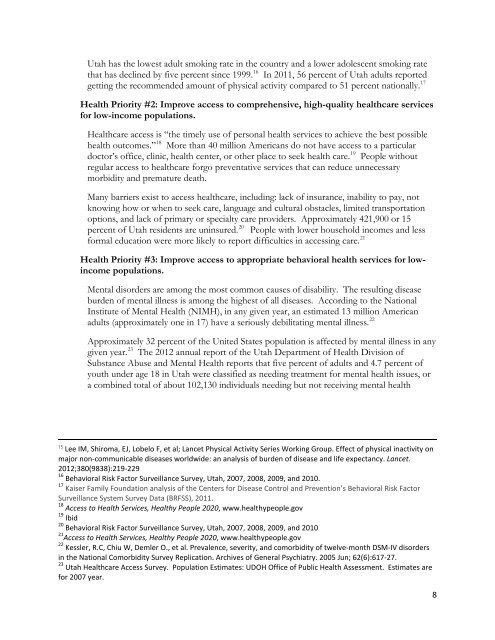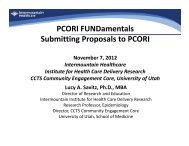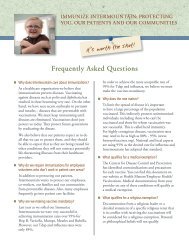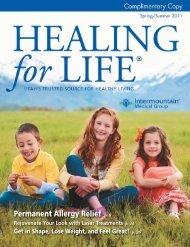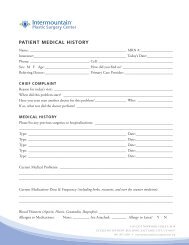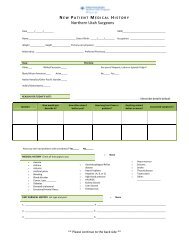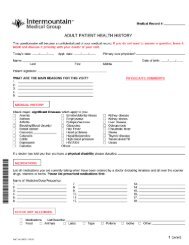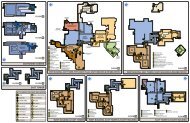Utah Valley Regional Medical Center CHNA - Intermountain ...
Utah Valley Regional Medical Center CHNA - Intermountain ...
Utah Valley Regional Medical Center CHNA - Intermountain ...
Create successful ePaper yourself
Turn your PDF publications into a flip-book with our unique Google optimized e-Paper software.
<strong>Utah</strong> has the lowest adult smoking rate in the country and a lower adolescent smoking ratethat has declined by five percent since 1999. 16 In 2011, 56 percent of <strong>Utah</strong> adults reportedgetting the recommended amount of physical activity compared to 51 percent nationally. 17Health Priority #2: Improve access to comprehensive, high-quality healthcare servicesfor low-income populations.Healthcare access is “the timely use of personal health services to achieve the best possiblehealth outcomes.” 18 More than 40 million Americans do not have access to a particulardoctor’s office, clinic, health center, or other place to seek health care. 19 People withoutregular access to healthcare forgo preventative services that can reduce unnecessarymorbidity and premature death.Many barriers exist to access healthcare, including: lack of insurance, inability to pay, notknowing how or when to seek care, language and cultural obstacles, limited transportationoptions, and lack of primary or specialty care providers. Approximately 421,900 or 15percent of <strong>Utah</strong> residents are uninsured. 20 People with lower household incomes and lessformal education were more likely to report difficulties in accessing care. 21Health Priority #3: Improve access to appropriate behavioral health services for lowincomepopulations.Mental disorders are among the most common causes of disability. The resulting diseaseburden of mental illness is among the highest of all diseases. According to the NationalInstitute of Mental Health (NIMH), in any given year, an estimated 13 million Americanadults (approximately one in 17) have a seriously debilitating mental illness. 22Approximately 32 percent of the United States population is affected by mental illness in anygiven year. 23 The 2012 annual report of the <strong>Utah</strong> Department of Health Division ofSubstance Abuse and Mental Health reports that five percent of adults and 4.7 percent ofyouth under age 18 in <strong>Utah</strong> were classified as needing treatment for mental health issues, ora combined total of about 102,130 individuals needing but not receiving mental health15Lee IM, Shiroma, EJ, Lobelo F, et al; Lancet Physical Activity Series Working Group. Effect of physical inactivity onmajor non-communicable diseases worldwide: an analysis of burden of disease and life expectancy. Lancet.2012;380(9838):219-22916 Behavioral Risk Factor Surveillance Survey, <strong>Utah</strong>, 2007, 2008, 2009, and 2010.17 Kaiser Family Foundation analysis of the <strong>Center</strong>s for Disease Control and Prevention’s Behavioral Risk FactorSurveillance System Survey Data (BRFSS), 2011.18 Access to Health Services, Healthy People 2020, www.healthypeople.gov19 Ibid20 Behavioral Risk Factor Surveillance Survey, <strong>Utah</strong>, 2007, 2008, 2009, and 201021 Access to Health Services, Healthy People 2020, www.healthypeople.gov22 Kessler, R.C, Chiu W, Demler O., et al. Prevalence, severity, and comorbidity of twelve-month DSM-IV disordersin the National Comorbidity Survey Replication. Archives of General Psychiatry. 2005 Jun; 62(6):617-27.23 <strong>Utah</strong> Healthcare Access Survey. Population Estimates: UDOH Office of Public Health Assessment. Estimates arefor 2007 year.8


